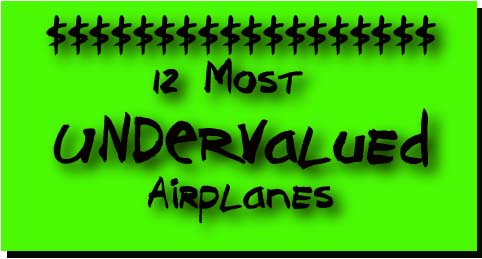

A quick note from 2007: although this was written in 2000, the subject airplanes and the comments about them still hold true and their relative values are the same. Only the actual dollar values are wrong. A quick scan through Trade-a-Plane will bear that out.
Most folks say an airplane is undervalued when it delivers more utility than its price, as judged against its peer group, reflects. By saying that, we are essentially saying that the market isn't as smart as it thinks it is or there would be no under valued airplanes. However, this just isn't true. The market has a way of finding out what's good and what's not so good and will pay accordingly. Airplanes that appear to be undervalued are often undervalued for a reason. Others are just misunderstood or the public doesn't really know them. However, just because an airplane has a drawback or two, doesn't make it worthless. In fact, if you're willing to live with some of those problems, you can be guaranteed of enjoying the same utility as the high dollar crowd, but you'll be paying much less. Let's look at a few specifics:
Take the Cessna 175 skylark, as an example of utility tainted by drawbacks. You may well ask, "...a Cessna what?" The 175 was produced from 1958-1962 and from 50 feet you'd be hard pressed to tell it from a C-172 of the same era (square tail, fast back), except for it's slightly chubbier nose and constant speed prop. The airplane has a solid 1000-1100 pound useful load and cruises at 120 knots plus while climbing at least 25-30% faster than a C-172 . It stands midway between the 172 and the 182 in almost all areas but is always priced 15-20% less than comparable Skyhawks. "So, what's it's draw backs?" you are wisely asking. The airplane hasn't been taken to the market's heart beaus all of that performance comes from a geared Continental, a GO-300, that puts out 175 hp, making the airplane sort of an early Hawk XP. The engine doesn't have a sterling reputation for longevity. Its TBO is 1200 hours, when today, 2000 hours is considered standard and that has resulted in a lower market price. Still, the airplane is a great value, providing your situation demands the performance and you don't put that much time on an airplane per year. Okay, so you buy one that has 200 hours on it. How long will it take you to put 800 hours on it? Six years? Ten? A lot of airplanes fall into this kind of category: Lots of performance and lots of airplane but something mechanical keeps their value down.
The Beechcraft series 50 Twin Bonanza is another airplane with geared engines that gives surprising performance
for the dollar. All of the versions are big and comfortable, but
the later versions with the side airstair door are true cabin class
airplanes at single engine prices. Blue Book value on the Twin-Bo
range from $40,000 for the early 260 hp birds (GO-435) up to $73,000
for the fire breathing E50s with 340 hp per side (IGSO-480). Here's
a ridiculously roomy, six place airplane that, depending on the model,
has a useful load of anywhere from 1700 to 3000 pounds and cruises
from 160 to 185 knots. By comparison, an E55 Baron will cruise 10
knots faster, but carries 1,000 pounds less than the last Twin-Bo's
and its Blue Book price tag is twice as high. A 58P Baron will run
away and hide from the old, lumbering Twin-Bo with a 50 knot speed
advantage but it carries 800 pounds less and costs three times as
much, $200,000 plus. So, what's the trade-off with the old Twin-Bo?
The first problem is finding one in good condition, as so many have
been let go derelict, and the second is, again, the engines. They
are short lived and expensive to overhaul. The answer? There isn't
one. You enjoy the comfort of the Twin Bonanza knowing you'll be
doing engines sooner rather than later or you opt for an airplane
with better engines that's much more expensive. Ain't nothin' free
in aviation.
|